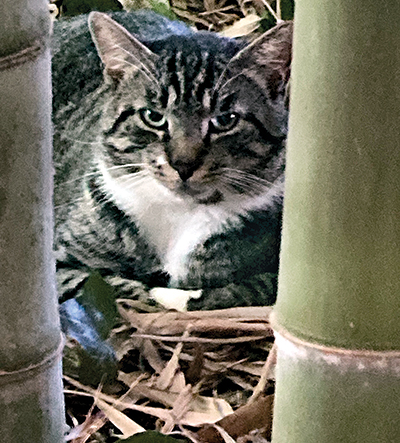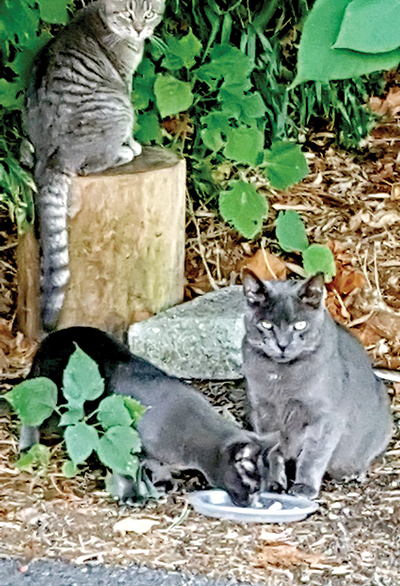by Suzanne Caciola and the late Diane Gravatt –
Part 1:

Urbanna is a tiny town with a long history. Descendants of the early settlers still live in town or the surrounding community. Their names appear on properties and buildings. Museum in the Streets has helped polish up the history of the town and make it readily available to both residents and visitors.
But, some descendants are not even mentioned. If you are lucky, you might catch a glimpse of one of those original direct descendants moving stealthily through town.
Today’s feral cat population in Urbanna is linked to the colonial ships arriving from European ports. Cats were a fixture on British ships and were considered part of the crew.
They protected the cargoes of grain, foodstuffs and tobacco from rats and mice. Sailors realized that they were reliant on the cats to protect provisions on board and the ships themselves. Cats protected the dock lines and rigging of the ships from destruction by the vermin.
Starvation was always a concern and the cats helped prevent loss of foodstuffs. No crew risked leaving port without one or more cats on board. To the sailing men, the cats became more than just a vermin control system. Living in such close quarters, they became morale boosters and friends of sailors who were far from home and existing in the often harsh environment of the sea, where a friend was often needed.
Mariners became even more indebted to their cats as they discovered they were a trusted tool in predicting changes in weather. Cats have a great sensitivity to natural phenomenon, far superior to human faculties. Before modern meteorological devices, their ability to detect changes in barometric pressure, because of their very sensitive inner ear, might have been as accurate if not more so than any other technology at that time. Each feline had its own set of mannerisms and postures to communicate the weather forecast. Understanding the cats behavior warned sailors about changes in natural weather phenomenon and upcoming storms. If a sailor could read his cat, he could predict the weather.
Famine and plague were long-standing problems in Europe. Mass extermination of cats in parts of Europe contributed to the spread of both famine and plague, because it led to an increased population of rats and mice, carriers of the plague.
The domestic cat did not develop from an indigenous species known in the New World. Rather, domestic cats immigrated on the ships coming to both North and South America. The age of colonization became the age of feline expansion. Explorers and settlers brought many animals with them to the New World that were not native in either North or South America. They brought horses, cattle, oxen, pigs, dogs and cats with them to the New World. There is written mention of cats in Jamestown in 1609. Early settlers used the cats to control rats and mice in barns and fields. As natural predators, they also helped protect against snakes, moles and large insects.
Part 2:

Excerpts from the Virginia Gazette in 1773 list several cargo and packet ships that arrived in Urbanna harbor. The cargo ship “London” arrived in Urbanna in July 1773. The cargo ship “Noble Bounty” arrived in November 1773, the “Liberty” in June 1774, the “Molly” in July 1775 and the packet ship “Fredericksburg” in August 1784. On board were most likely, some of the “favorites,” a colonial name for a pet and some of the ship’s cats.
The cats roamed freely aboard the ships and departed just as freely to explore their new surroundings. Understanding the value of cats for vermin control, there is the expectation that many local settlers may have encouraged cats to remain in their barn, building or warehouse. Early farmers were known to cut a small hole in a doorway and place a flap over the hole to allow the cats access to the building. Sound familiar? There was a colonial saying, “you will always be lucky, if you know how to make friends with a strange cat.”
The cats remained as permanent settlers along Urbanna’s waterfront. Local historian Larry Chowning remembers, as a child, watching Ruth Haywood, of Haywood’s Store, feed a group of cats every day.
The classic Urbanna cats are short haired and solid gray, with an occasional long-haired fluffy coat. Others may be black with a white dot on the chest. A combination of white, gray and black also grace us. Through the years, Urbanna has had a variety of small colonies of these survivors scattered throughout the town. The same faces having walked here so many years ago.
Urbanna cats hold company with other well known colonies. The polydactyl, (six-toed) Hemingway cats of Key West, Fla., are descendants of “Snow White,” Ernest Hemingway’s cat. She was a gift to Hemingway from a sea captain, Stanley Dexter, in 1930. Today, about 40 to 50 of the cats live and are cared for as part of the Hemingway house museum.
Thousands of visitors come each year to visit the house, grounds and cats. Hemingway cats can cost more than $1,000 to purchase and adopt. Ocracoke Islanders have also embraced their feral cat population. “Thurston” guarded the Ocracoke lighthouse and greeted visitors for nearly 20 years. The islanders have developed a legend that their cat population came to the island with the pirate Blackbeard.
Some years ago, the Town of Urbanna partnered with “The Cat’s Meow” to promote the historical buildings in Urbanna. “The Cat’s Meow” is a company that produces wooden replicas of buildings and landmarks with colorful details. Included on each piece is the owner’s cat, “Casper.”
These reproductions are still available in shops around town and help support the towns historic fund. Perhaps without realizing that while promoting the historical buildings of Urbanna, we were also promoting the history of the cats of Urbanna. Like the wild horses of Chincoteague and the Outer Banks, the cats of Urbanna meld into the landscape and are part of its history.
The Urbanna Cat Project needs your help. The organization seeks to make an effective, humane, cooperative and lasting impact on the feral cat population of Urbanna by organizing volunteers, educating members of the community and humanely decreasing the number of feral cats using the Trap-Neuter-Return (TNR) method and has spearheaded spaying and neutering 600 cats over the past 12 years. It also provides medical care. Food is supplied by its generous volunteers. It is out of money and seeks aid from the community to continue its work of helping the feral cats in Urbanna.They have kitties that need your help now. Please send your donations to Urbanna Cat Project, C/O The Allen Group, P.O. Box 758, Urbanna VA 23175.
(Suzanne Caciola is co-founder of the Urbanna Cat Project. The late Diane Gravatt was a former Urbanna mayor. For more information, visit the Urbanna Cat Project Facebook page.)



